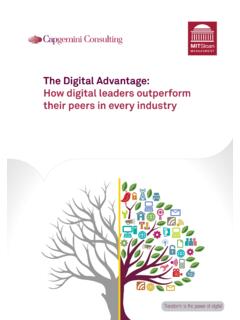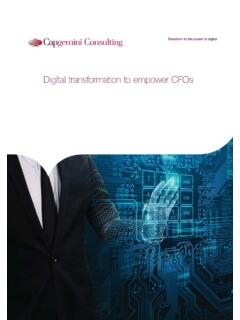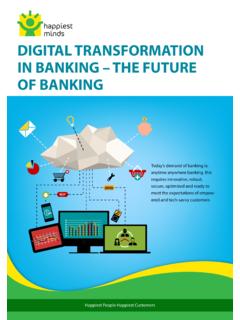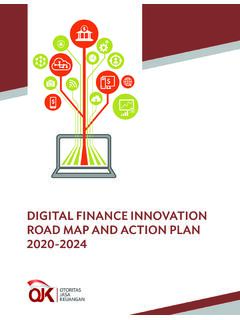Transcription of DIGITAL TRANSFORMATION: A ROADMAP FOR BILLION …
1 DIGITAL transformation : A ROADMAP FOR BILLION -DOLLAR ORGANIZATIONS FINDINGS FROM PHASE 1 OF THE DIGITAL transformation STUDY CONDUCTED BY THE MIT CENTER FOR DIGITAL BUSINESS AND CAPGEMINI CONSULTINGMITS loan MANAGEMENT2 2011 MIT Center for DIGITAL Business and Capgemini Consulting Contents3 2011 MIT Center for DIGITAL Business and Capgemini Consulting 1 The Study 062 Common pressures; different results 08 Common pressures to begin DIGITAL transformation Different DIGITAL transformation speeds and different results Case Study: Finding new opportunities for DIGITAL transformation across a hospitality company Case Study: DIGITAL transformation in India3 The shape of DIGITAL transformation 16 Transforming customer experience Transforming operational processes Transforming business models DIGITAL capabilities Case Study: DIGITAL transformation in an international banking group Case Study: Moving from separate to integrated DIGITAL initiatives in an apparel manufacturer4 DIGITAL technology usage 285 Challenges on the road to transformation 34 Initiation challenges Execution challenges Governance challenges Case Study: Evolving as a value chain orchestrator in mortgages Case Study.
2 DIGITAL transformation in an international airport6 How can you make your DIGITAL journey successful? 46 Envision the DIGITAL future for your firm Invest in DIGITAL initiatives and skills Lead the change from the top Case Study: Driving DIGITAL transformation across a global media company7 What is DIGITAL transformation maturity? 58 The What and the How DIGITAL Maturity Matrix How to assess your DIGITAL maturity Case Study: Capitalizing on DIGITAL opportunities for a business directory8 Conclusion 654 2011 MIT Center for DIGITAL Business and Capgemini Consulting EXECUTIVE SUMMARY5 2011 MIT Center for DIGITAL Business and Capgemini Consulting DIGITAL transformation (DT) the use of technology to radically improve performance or reach of enterprises is becoming a hot topic for companies across the globe. Executives in all industries are using DIGITAL advances such as analytics, mobility, social media and smart embedded devices and improving their use of traditional technologies such as ERP to change customer relationships, internal processes, and value propositions.
3 Other executives, seeing how fast DIGITAL technology disrupted media industries in the past decade, know they need to pay attention to changes in their industries now. How can senior executives successfully lead DIGITAL transformation ? While many experts urge companies to get started on the DIGITAL transformation journey, few tell how to do it. In this report we share the findings from a global study of how 157 executives in 50 large traditional companies are managing and benefiting from DIGITAL transformation . We will describe the elements of successful DIGITAL transformation and show how to assess your firm s DIGITAL research shows that, although large traditional firms are truly different from DIGITAL entrants, many are starting to transform their businesses successfully through DIGITAL technology. Specifically, Companies face common pressures from customers, employees and competitors to begin or speed up their DIGITAL transformation .
4 However they are transforming at different paces with different results. Successful DIGITAL transformation comes not from implementing new technologies but from transforming your organization to take advantage of the possibilities that new technologies provide. Major DIGITAL transformation initiatives are centered on re-envisioning customer experience, operational processes and business models. Companies are changing how functions work, redefining how functions interact, and even evolving the boundaries of the firm. Successful DT does not happen bottom up. It must be driven from the top. Focus on the how more than the what. The most successful transformations we have seen focus as much (or more) on how to drive change as on the detailed content of the change. A compelling transformative vision, with related engagement, governance and KPIs will allow people throughout the enterprise to identify new whats to meet or extend the vision.
5 Successful DT comes not from creating a new organization, but from reshaping the organization to take advantage of valuable existing strategic assets in new ways. Companies can do much more to gain value from investments they have already made, even as they envision radically new ways of the hype around innovative DIGITAL technologies, most companies still have a long way to go in their DIGITAL transformation journeys. Leadership is essential. Whether using new or traditional technologies, the key to DIGITAL transformation is re-envisioning and driving change in how the company operates. That s a management and people challenge, not just a technology 2011 MIT Center for DIGITAL Business and Capgemini Consulting 1 THE STUDY7 2011 MIT Center for DIGITAL Business and Capgemini Consulting Many popular stories of DIGITAL transformation involve DIGITAL start-ups or high-tech firms such as Amazon, Apple, or Google.
6 Executives in traditional companies often find these examples hollow. Big traditional companies, with decades of history and legacy, are simply different from these newer DIGITAL entrants. Other stories focus on exciting initiatives by traditional companies, but are anecdotal and do not show how those companies implemented the change. These examples may be good triggers for other companies to take action, but they give no advice on how or whether to do that in mind, MIT Center for DIGITAL Business and Capgemini Consulting set out investigate the ways in which large traditional companies around the world are managing and benefiting from DIGITAL transformation . We are working to understand how DIGITAL technology is changing the business of large leading firms. Phase 1 of this multi-year study is an exploratory investigation involving 157 executive-level interviews in 50 companies in 15 countries (see Figure 1).
7 These companies are large, with typically $1 BILLION or more in annual sales. We conducted in-depth interviews to qualitatively explore the nature of the DIGITAL transformation phenomenon with real executives in real companies. To provide balanced perspectives, approximately half of the interviewees are business leaders such as CEOs, line of business managers, marketing heads, or COOs, while the other half are IT and technology & Canada 30%Asia Pacific16%Pharmaceuticals & Medical Transport Manufacturing & distribution Energy, Utilities and Chemical Telecom, Media, and Entertainment ServicesGovernment Retail & Food services 6%20%8%12%8%22%12%Financial Services12%Figure 1: Interviews cover a broad range of countries and industries8 2011 MIT Center for DIGITAL Business and Capgemini Consulting 2 COMMON PRESSURES; DIFFERENT RESULTS9 2011 MIT Center for DIGITAL Business and Capgemini Consulting Common pressures to begin DIGITAL transformation The executives we interviewed report feeling pressure to transform from forces inside and outside the company.
8 Figure 2 shows that most executives expressed at least moderate pressure to change. Employees are asking why they cannot collaborate with coworkers the way they can with friends. One executive quoted younger employees as saying Come on. I know the company s more than 100 years old, but our IT capabilities don t have to match the age of the company. Other employees are incorporating their personal practices into their work lives without waiting for corporate practices to catch up. According to one CIO, Officially iPads are prohibited by our policies. Yet 50 percent of our employees are using them at work. Customers, too, are becoming more demanding. An airport executive described an ever-rising tide of customer expectations for service and convenience. For a manufacturer/retailer, People s expectations have changed. They want to be more in charge. They expect that we know them online behavior is developing expectations and behaviors that they apply in other contexts as well.
9 Nearly every executive (72 percent) cited competitive pressures to change. This relates closely to increases in the pace of business. Respondents rated the current pace of business relative to five years ago as on a scale from 1=very much slower to 7=very much faster. Most indicated the pace will continue to increase, leading to further pressure to transform their businesses. While several executives indicated this was the new normal for their Executives rated the pace of business compared to five years ago as out of 7**Scale: 1=very much slower than 5 years ago, 7=very much faster than 5 years agoHigh MediumCustomersCompetitorsEmployees72%32 % 70%HHHMMM* Percentage of companies experiencing moderate or high pressure to transform from customers, competition, or employees as mentioned by their executives. Some firms mentioned more than one 2: Pressures for change*10 2011 MIT Center for DIGITAL Business and Capgemini Consulting industries, others expressed concern that the acceleration would not be on average rated their innovation culture at only on a 7-point scale.
10 Although few companies strive to be as high as seven on the scale, none of the executives felt their innovation culture was as strong as it should executives expressed other, less common, pressures. Globalization is a driver for seven firms. These companies have a strategic need to expand globally or are facing pressures to generate information and process synergies across their global enterprises. Executives in three firms mentioned M&A as a pressure to Different DIGITAL transformation speeds and different resultsA few companies in our study are using DIGITAL technologies, old and new, to truly transform their businesses. However, these companies are in the minority. Despite internal and external pressures, very few businesses are gaining the full value of technologically-enabled change, even with technologies they already own. Many companies we interviewed took on the significant effort and expense of implementing ERP, CRM or other technology-enabled changes, but obtained only basic levels of value from the investments.


















